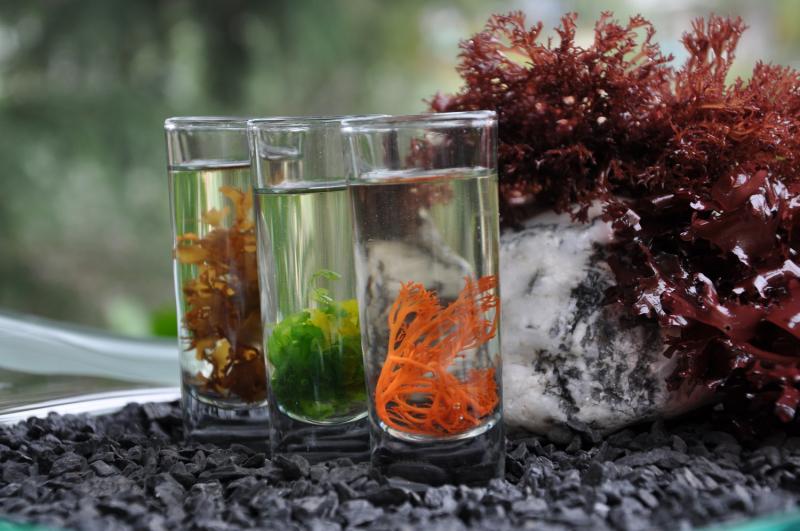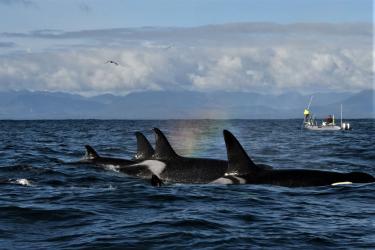California’s Monterey Bay Seaweeds cultivates edible seaweeds, including West Coast dulse, sea lettuce, sea grapes, and ogo. These are all sustainably farmed in land-based tanks, harvested to order, and available year-round. The business is family owned by co-founders Dr. Michael Graham, a professor and seaweed biologist, and Erica Graham, a chef and restaurateur.
Michael says, “We’re a family and wanted to make seaweed into something that complements both of us, so we went culinary. Seaweed is my expertise and Erica knows what products chefs want. Knowing the restaurants and the seaweed is what gets us into the high-end markets.”
Monterey Bay’s seaweeds are farmed using a land-based, sea water recirculating system. By cultivating seaweeds in tanks, there are no negative impacts to wild seaweed populations. The only inputs needed to grow seaweed are sea water and sunshine; they do not add feeds, additives, or chemicals to the tanks. As Michael explains, “The water from the bay is already naturally fertilized through a process called coastal upwelling—not only do we not have to pay for fertilizer, it’s organic.”
A Focus on Sustainability
Monterey Bay Seaweeds is a founding member of the Coalition for Sustainable Aquaculture. The organization strives toward “inclusive jobs, thriving coastal communities, and homegrown seafood.” Michael points out that some regulations can make it tough to farm seafood, but this can be overcome if chefs, farmers, regulators, and other groups communicate effectively.
The farm partners with San Jose State University’s Moss Landing Marine Laboratories (where Michael is a professor), occupying a site at the campus aquaculture facility. This is the university’s first public-private partnership for increasing entrepreneurship and workforce development in aquaculture. Two other companies have since joined the facility, and the venture invites other entrepreneurs and universities to combine resources.
From Farm to Table
Monterey Bay Seaweeds supplies seaweeds directly from the farm to restaurants and chefs nationwide. The company does not ship internationally because seaweeds are shipped live, and will not survive delays during customs screening. As the website states, products are always delivered “Fresh, raw, and alive.”
Fun Fact
Calling all chefs! If you have experienced a great tasting seaweed harvested from the wild and are looking to find a sustainable and dependable source, let Monterey Bay Seaweeds know. They might be able to farm your favorite variety in their land-based tank system.
Recipe: Homemade Dulse Popcorn
Try this twist on stovetop popcorn from the Monterey Bay Seaweeds blog.
Ingredients:
- 2 tablespoons of oil (We used Thrive algae oil, which is high in omega 3s and has a relatively high smoke point)
- 1/3 cup popcorn kernels
- 1–2 oz of dulse
Instructions (for 1/3 cup uncooked popcorn):
- Heat oil in a large pot on medium heat. Rinse dulse under cold fresh water and pat dry with towels.
- Place a few (2–3) popcorn kernels in the pot. Once they pop, the oil is the correct temperature. Remove the popped corn and remove the pot from the heat.
- Add in the kernels and dulse. Have a lid ready and cover after adding the dulse. The moisture in the dulse will cause splatter so make sure to cover right away.
- Let the kernels and dulse sit for 1 minute off the heat then place the pot back onto the heat.
- After the popcorn stops popping, remove from heat and transfer to a serving bowl. Mix up the fried dulse and popcorn and give it a try. If you find you want more flavor, proceed to step 7.
- Add some butter and extra seasoning (garlic, salt, pepper) to the heated pot and let it melt. Then drizzle on the popcorn and mix together.
- Enjoy!
Sources:
Sustainable Seafood from Tide to Table
The Tide to Table series profiles members of the aquaculture community, who provide valuable jobs and increase access to fresh, sustainably sourced American seafood. Aquaculture is more than seafood production. It is ecosystem stewardship, coastal communities, and economic opportunities.





